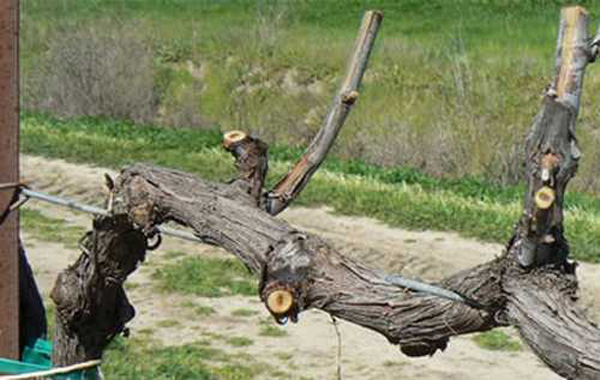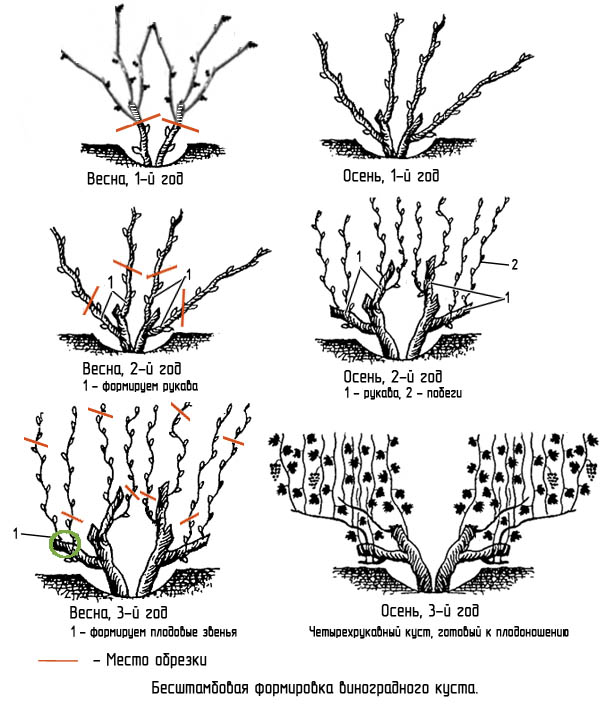Pruning grapes in spring or the path to a rich harvest
Every summer resident knows that such an agricultural technique as pruning is necessary for all fruit and berry crops. In order for grape pruning in spring to be successful, you need to know how to properly carry it out and what is needed for this. The information contained in the article will provide answers to these and many other questions regarding spring pruning.
Content
Why do you need pruning
The grapes must be pruned in order to obtain a large and generous harvest. Pruning contributes to the development of a richer flavor and affects the size of the berries.
 Many gardeners also note that after they began to circumcise, the procedure for caring for this berry crop was simplified, and harvesting became much easier. After all, a vine, if not pruned every year, can grow significantly and put new branches in different directions. The plant can grow so much that it will begin to climb the walls of a house or trees growing nearby. You should also know that by pruning grapes, we accelerate the ripening process. If you want to increase your frost resistance, this procedure will also help you with this.
Many gardeners also note that after they began to circumcise, the procedure for caring for this berry crop was simplified, and harvesting became much easier. After all, a vine, if not pruned every year, can grow significantly and put new branches in different directions. The plant can grow so much that it will begin to climb the walls of a house or trees growing nearby. You should also know that by pruning grapes, we accelerate the ripening process. If you want to increase your frost resistance, this procedure will also help you with this.
Spring pruning rules
Before proceeding with spring pruning, you need to know that this procedure cannot be carried out when the plant is at the beginning of the sap flow period. Ignoring this moment, at best, you can not count on high yields, and with the worst forecast, you can completely ruin the bush. As soon as the ambient temperature stops fluctuating and settles at around +5 degrees, carefully examine the crown: whether the shoots have suffered from frosts that were in winter. Then you can proceed to circumcision.
Pruning grapes in the spring is pretty straightforward. The main thing is to know what it is aimed at. So, young grapes must be cut to form the skeletal parts - stem, sleeve and shoulder. And when cutting off already fruiting bushes, they leave the required number of branches that will yield a harvest, and it is also advisable to leave 2-3 branches to rejuvenate the crown. Removing a perennial shoot completely, you should leave a stump up to 10 mm high. Leaving a larger stump, you will notice that after a while it will begin to crack and injure the tissues below.

Cropping Toolkit
Before proceeding with cutting the vine, it is necessary to prepare in advance the tools that you will need for manipulation. First of all, it is a grape pruner, a grape saw, and a garden knife. The pruning shear blades should be very sharp to help ensure a clean and correct cut. To check the sharpness of the blade, you can carry out the following event. Take a thin sheet of paper and run the blade over the paper. If you did it easily and effortlessly, then the blades are sharpened quite sharply. A garden knife will come in handy after the end of the procedure to clean the surface of large wounds.
A tool such as a grape saw has thin blades and fine teeth, as a result of which the crown will not sway much when cutting and it will be easier for you to make the intended cuts. It is best to use this saw to remove thick, bulky parts of the plant.

Cut old branches so that the pruning shear blade only runs at right angles. Due to this, the wounds formed during pruning will have a small area and heal faster.If you have to cut thick branches, then you will have to cut them in several steps, while the movements should be sliding and light. In order to perform the pruning correctly, the part of the branch that we are removing should be slowly and carefully guided by hand towards the secateurs stop. By doing these measures, we can avoid deformation of the vine.
Before you start pruning a young bush, study the state of the growth. The first step is to remove dry, damaged and deformed parts. If diseased sprouts are present, they must also be disposed of. This pruning procedure is often referred to by growers as "lightening".
Pruning a young grape bush
Young shoots of grapes are advised to be cut with pruning shears 2-3 cm higher from the location of the lower eye. This cut point was not chosen by chance, but so that with the arrival of spring the sap does not moisten the peephole. Pruning a young bush is aimed not only at correctly forming the main skeletal parts of the bush, but also for selecting those branches that will harvest in the coming year. It is also necessary to prune grapes in spring in order to rejuvenate that part of the crown that has grown old.
During spring pruning, up to 90% of the one-year young growth should be removed. At first glance, such pruning will seem ruthless to you, but it will allow the plant to develop correctly and evenly and contribute to an excellent harvest in the future.
Pruning wounds and care
After the circumcision procedure, wounds form. Any wound causes considerable harm to the plant. It is especially dangerous when there are many of them and they are large in size. A grape wound with a diameter of 1.5 cm heals for a long time. This causes the appearance of necrosis on the vine, the plant becomes weak and, in the absence of timely assistance, may die.

However, if the wounds are located on one side of the shoulder (sleeve), then the plant will not suffer significant damage. This can be achieved by placing the replacement knots on only one side annually. Moreover, their location should go down from the fruit arrow. The one-sided arrangement of the wounds ensures an even supply and distribution of nutrients throughout all the branches of the bush.
Deep wounds located on different sides of the skeletal parts will lead to the fact that the paths along which the distribution of nutrients passes will become tortuous and in places, due to dead tissue, will be interrupted. Due to the lack of nutrients, the crown will begin to grow poorly and bear fruit, the skeletal parts will gradually begin to dry out.
When circumcising, try to keep the wounds small, especially if you are pruning a perennial bush. When removing completely annual shoots, try not to damage the wood, because this can lead to the appearance of dead tissue (necrosis) in the future. Sleeves and shoots are cut off at the base, while keeping pads 0.5 cm thick. To reduce the wound area in perennial branches, the cut must be made perpendicular to the axis of the branch and it must be smooth.
Video "Pruning grapes in spring"
This video will tell you about the rules for pruning a vine in the spring.
Beginners need to know
Having planted grapes on their site, novice gardeners do not take into account that it is necessary to carry out circumcision and form a fruitful culture. They do not attach due importance to the procedure itself. Feeling sorry for the plant, gardeners do not dare to carry it out according to all the rules, namely, to remove up to 90% of the growth, mistakenly believing that light pruning will help preserve the bush and get a good harvest. And therefore, only the tops or the vine, which has already dried and become dry, are cut off.
However, one must understand that such a "sparing" pruning will bring new troubles and problems in the future.If the grape crop is cut in this way annually, then the bushes will grow strongly, the branches will begin to curl very densely, due to this, sunlight will fall on the plant unevenly, which will lead to disturbances in the distribution of essential nutrients.
As a result, the summer resident will receive a thin vine, a poor harvest: the berries will be of a non-marketable type, without a rich taste. Such berries are unsuitable even for wine production. All work (watering, fertilizing, loosening) will simply be wasted. Based on this, carry out a correct and complete pruning, even if it seems unnecessarily brutal to you. Positive results won't keep you waiting long.

Another point to pay attention to is the trim length. It directly depends on the thickness of the vine. The thicker the shoot, the longer the vines need to be preserved.
Also, beginners should correctly identify the ripe vine that needs to be preserved. This vine usually takes on a slightly brown color. Grape novices should also know that thick vines do not bear fruit, their main function is to carry nutrients. With the arrival of spring, the necessary substances will "pass" along it, which will ensure the growth of the bush.
Having planted grapes, keep in mind that in addition to regular watering and fertilization, for the successful development of the plant, due attention must be paid to pruning. It must be carried out annually. After all, it is she, as long-term experience shows, significantly affects all stages of growth, development and fruiting of grape culture. Most importantly, do not spare the crown: the more you cut, the greater the harvest (of course, you must follow the rules of cutting). Remember: the correct pruning of grapes in the spring is the key to a decent harvest.
